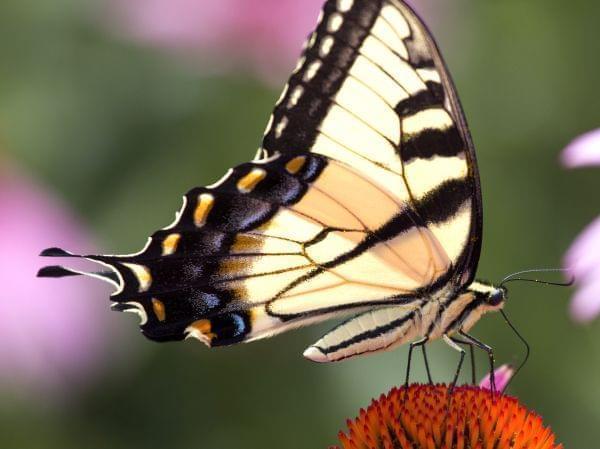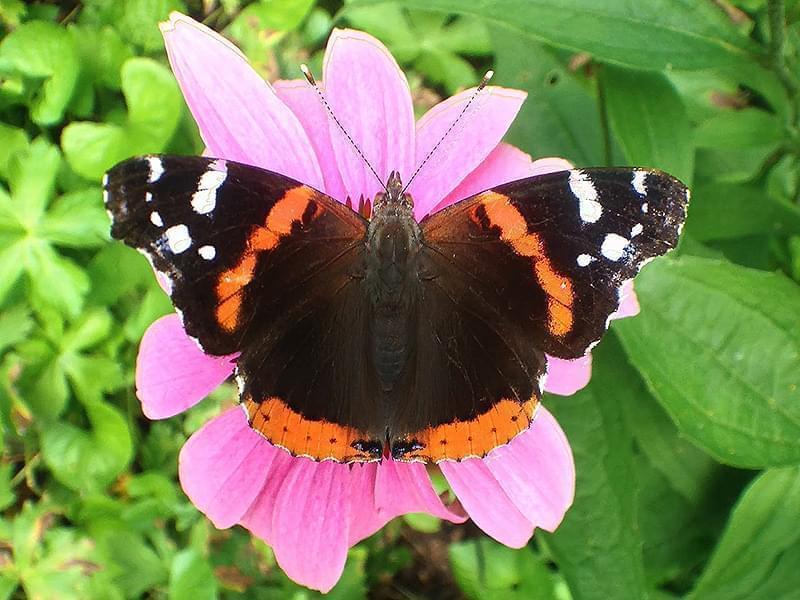Late summer a great time to expand your butterfly horizons [from the archive]

Tiger swallowtail, yellow form, on purple coneflower, in U of I campus planting. Rob Kanter
Everybody loves monarch butterflies, don’t they? And for good reason. Monarchs are gorgeous to look at, they live a fascinating life, and they’re super easy to identify. No wonder they’ve been designated “state insect” by Illinois—as well as Alabama, Idaho, Minnesota and Texas. If you appreciate monarchs but haven’t ever developed your capacity to identify other butterflies, late summer is great time to do it.
You could start by clarifying for yourself the difference between monarchs and their smaller look-alikes, viceroys. Experienced observers may be comfortable telling them apart based on size alone, but people who wish to confirm the identity of a viceroy by way of a field mark can do so. Look for an extra black line cutting across the front-to-back black veins on the viceroy’s back wing.

Viceroy Butterfly
After monarchs, the next most widely recognized butterflies in most of the U.S. are likely tiger swallowtails, thanks to their large size and striking black-on-yellow color scheme. What you may not know is that there’s another color scheme that occurs in a subset of female tiger swallowtails. They are dark all over, although the black “tiger stripes” are still distinguishable, especially on the undersides of their wings.
These dark form tiger swallowtails are one of five mostly black Illinois butterfly species that have evolved to resemble pipevine swallowtails because pipevine swallowtails are highly unpalatable. (That’s to say eating them—either as caterpillars or adults—causes other animals to throw up.) For most people, distinguishing among members of the pipevine swallowtail mimicry complex, as this group is known, requires a significant amount of practice, as well as a good field guide, and I’m coming around to that.
But before I do, I have one more nominee for a butterfly everyone can know with very little guidance, red admirals. They have been incredibly abundant in Illinois this summer, and were especially noticeable on stands of purple coneflower in June and July.

Red Admiral
How do you know when you’re looking at a red admiral? It’s just over half the size of a monarch and mostly black on the upper side, except for a set of red-orange bands that form a rough semi-circle, and some white spots near the front wing tips. The gray and brown markings on the undersides of the wings of a red admiral, which you see when they’re folded, are far less showy, but even there little splashes of blue and red provide the clues needed to identify them.
Now about that field guide. Illinois residents have access to an unparalleled resource as they start—or continue—their butterfly education, “Butterflies of Illinois: A Field Guide,” published by the Illinois Natural History Survey. In addition to color plates and photographs that help with identification, it also contains useful information about when and where to look for various species, as well as discussions of scientific questions of interest to amateur naturalists (such as the pipevine swallowtail mimicry complex). Really, if you’re at all interested in butterflies, or you know someone else who might be, this is the book. It’s most easily purchased by ordering online through the Webstore at the Illinois Natural History Survey, but other options are also included there.
One of the best ways to support butterflies is to plant the native trees and shrubs on which their caterpillars feed. You can buy select native trees and shrubs for fall planting through a sale being conducted by the East Central Illinois Master Naturalists this month. Details at this link: https://web.extension.illinois.edu/registration/default.cfm?RegistrationID=20030
